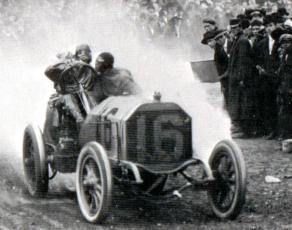
Locomobile #16 (1908)
First American Car to Win the Vanderbilt Cup Race
Make: Locomobile
Year: 1906
Mechanician:
Glenn Ethridge
Horsepower: 120
The Locomobile Company of Bridgeport, Connecticut built this racer in 1906 for the Vanderbilt Cup Race. The car's pressed alloy steel chassis supported a four cylinder engine with a bore and stroke of 7.25 inches each making for a total displacement of 1,197.2 cubic inches. This configuration delivered 120 horsepower. The 2,204 pound car had a wheel base of 110 inches or slightly more than nine feet. The tread was 54 inches, or four and a half feet. Hardened hickory artillery wheels were mounted to the car with Michelin tires. The front tire and wheel combination was 32 inches tall and four inches wide. The rear wheels (with tires) were taller at 35 inches and wider at five inches.
With Joe Tracy at the wheel and Al Poole as his mechanician, it won the 1906 American Elimination Race. A muddy track and inferior quality American tires robbed observers of any chance to see how the new racer could compete against the best Europe had to offer and finished a disappointing 10th in the 1906 Vanderbilt Cup Race, although it did have the fastest lap of any entry during the race.
The car was two years old when it was prepared for driver George Robertson and mechanician Glenn Etheridge for the 1908 Vanderbilt Cup Race. Bob Casey, Curator of Transportation at the Henry Ford, described Locomobile's participation in the race:
"Joe Tracy had retired from driving, so his car was in the hands of George Robertson, while Jim Florida drove the second car. Robertson’s car carried race number “16.” Florida’s race number was “1.” Both cars had improved tires and demountable rims that made changing easier.
Robertson and mechanician Glenn Ethridge repeatedly broke the lap record. Yet on the final lap, leading by 2 minutes and 22 seconds, Robertson’s car suffered a tire failure.
He and Ethridge frantically installed their last spare--then roared off to win the race by only one minute, 48 seconds..."
Locomobile used Old 16 extensively to promote its manufacturing prowess after the race, but as the novelty faded, it was placed in storage in a barn on Riker’s farm. Joseph Sessions, whose firm did much of the casting for the Locomobile engine, purchased the car in 1914. It was housed in a garage on his Bristol, Connecticut farm that was specially built to care for the car. There it was revered for 27 years and only driven by Sessions who occasionally took it to meets of the Veteran Motor Car Club.
When Sessions died in 1941, Peter Helck, the renowned automotive artist and author, acquired the historic racer with the assistance of his friend Joe Tracy. The car was delivered to his Boston Corners, New York home by none other than Joe Tracy in January 1942. Helck exhibited the car more frequently than Sessions, and allowed both Robertson and Tracy to drive it in touring events, including the 50th anniversary of the Vanderbilt Cup Race held in 1954 at Garden City, Long Island and several Bridgehampton meets.
When Peter Helck died on April 22, 1988, ownershiip of Old 16 had already been transferred to his son Jerry Helck. In 1997 the car was acquired by the Henry Ford Museum where it is currently on display-An American Legend.




Rollin’s granddaughter Betty King had this medal. She said she gave it to the National Inventors Hall of Fame Museum…